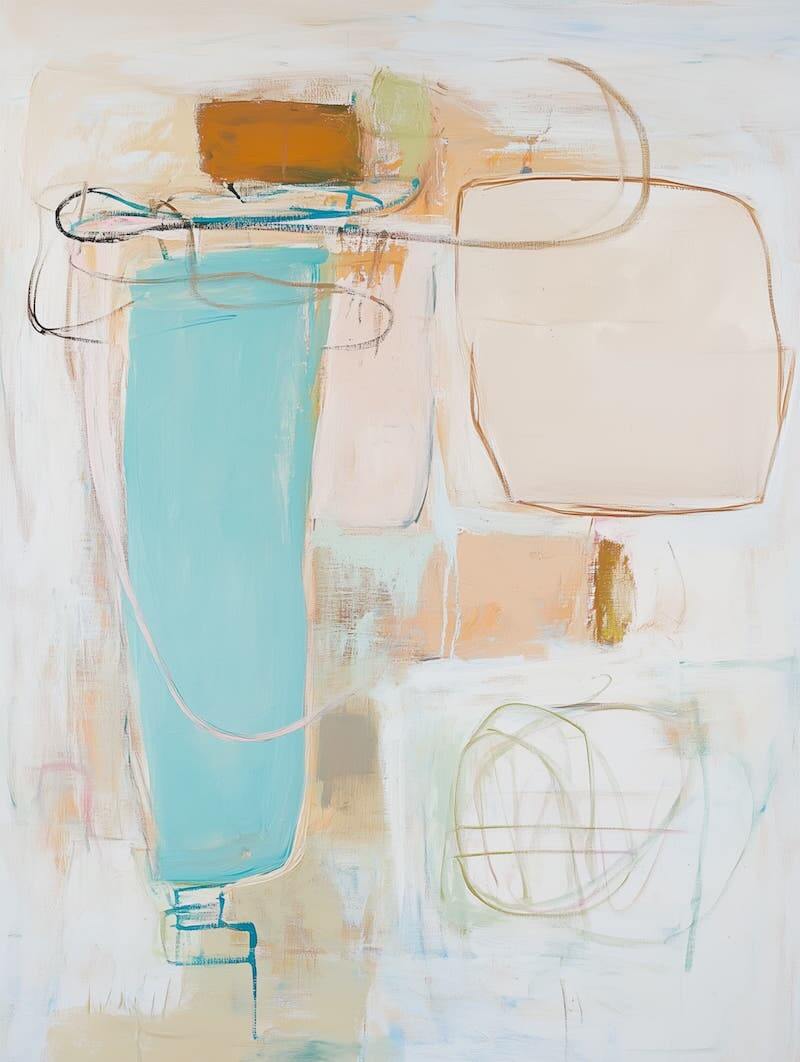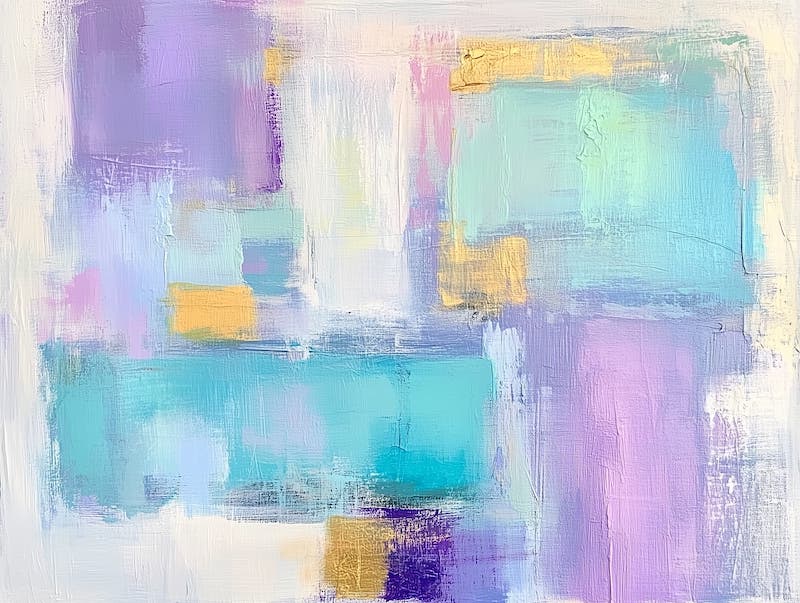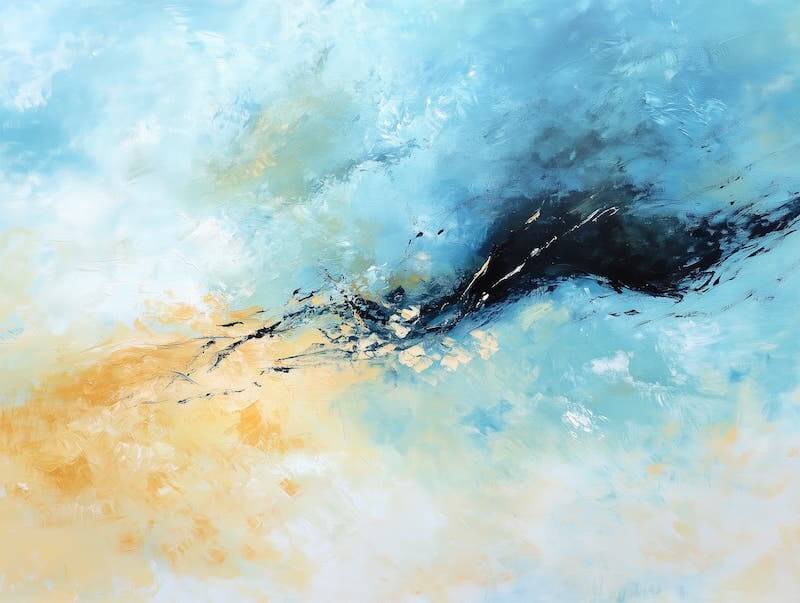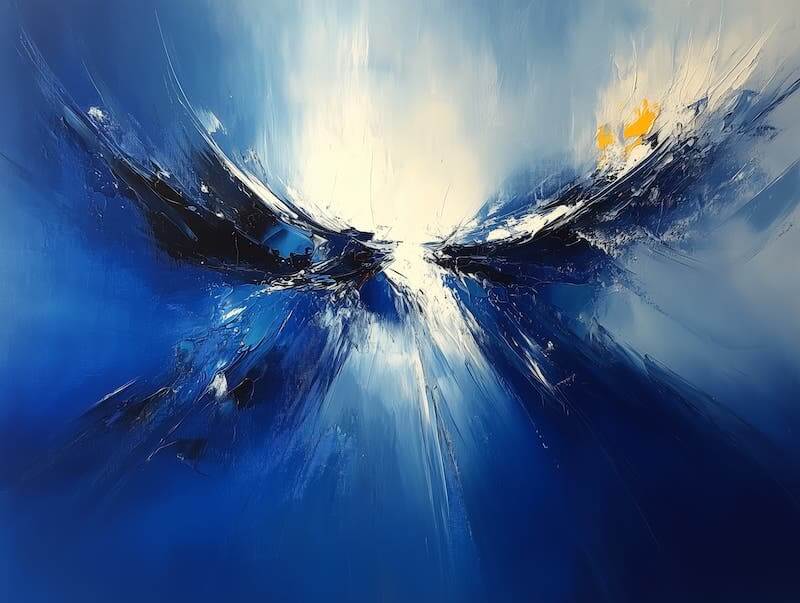Ever stood in front of a massive canvas splattered with paint and thought, “What am I looking at?”
That’s Abstract Expressionism. Raw emotion thrown onto canvas. No rules. No boundaries.
Born in post-World War II America, Abstract Expressionism put the United States on the global art map for the first time. The movement’s artists turned painting into an emotional experience rather than just a visual one.
Learning about Abstract Expressionism helps you understand a pivotal moment in art history, gives you insight into a timeless creative process, and can inspire you to decorate your home with authentic, emotionally driven artwork.
Quick Takeaways: Save This Guide to Abstract Expressionism
- Abstract Expressionism started in America after WWII, shifting the art world from Paris to New York
- These artists painted feelings, not things. Emotion and spontaneity rule
- Key figures: Pollock (drip paintings), Rothko (color fields), de Kooning (abstract figures)
- Women artists like Krasner and Frankenthaler made major contributions but got less recognition
- It changed everything about how we think of art—still influencing artists today
What Is Abstract Expressionism?

Abstract Expressionism is an art style that prioritizes emotional intensity over realistic representation. The “abstract” part means they moved away from depicting reality. The “expressionism” part means they focused on emotional impact.
Instead of painting recognizable objects or scenes, these abstract artists used color, line, and texture to express their inner feelings while leaving room for subjective interpretations.
Think splattered paint, enormous canvases filled with color, and energetic brushstrokes that capture the artist’s movements. These visual elements convey raw emotion directly to the viewer.
The movement flourished primarily in New York from the mid-1940s through the 1950s and represented America’s first major contribution to the international art world. It’s one of the last art movements to be recognized under the Modern Art umbrella. Later movements (60s–present) are typically classed as Contemporary.
What makes Abstract Expressionism special is its emphasis on the process of creation itself. For these artists, how they painted became as important as what they painted.
What Made Abstract Expressionism Different?
The world felt unstable after World War II, and artists needed new ways to express the anxiety and complexity of modern life.
European artists fleeing war brought fresh ideas to American shores, including Surrealism’s exploration of the subconscious mind. Abstract Expressionists took this further, letting instinct guide their hands with minimal planning. They developed a new visual language that valued personal expression over traditional representation.
They had help from some mentors, too. Hans Hoffman, a German expatriate teacher, showed American artists how to use color and expressive brushwork in revolutionary ways. At the same time, philosopher John Dewey’s ideas about emotional expression in art added intellectual fuel to the creative fire.
By the late 1940s, artists like Jackson Pollock, Willem de Kooning, and Mark Rothko were breaking free from conventional painting. Their work prioritized spontaneity. Gesture. Emotional intensity.
These abstract expressionists sought to tap into universal themes and the collective unconscious. Their approach to modern painting rejected both the rigid formalism of Western European painting and the social realism that dominated American painting in the 1930s.
The New York School Takes Center Stage
For years, Paris had been the center of the art world, but this artistic revolution put the spotlight on New York City. A loose group called “The New York School” (named by artist Robert Motherwell) nurtured the emerging Abstract Expressionist artists and elevated the style from fringe antics to a full-blown movement.
These artists embodied American individualism and experimental spirit. Many had personal connections to the war—as veterans, immigrants, or participants in war efforts. For the first time, an international art movement originated in America instead of Europe.
The term “Action Painters” stuck after critic Harold Rosenberg coined it in 1952. He recognized these artists weren’t just making images—they were performing acts of creation. The canvas became an arena for artistic battle.
Think of Pollock circling his canvases on the floor, flinging paint in arcs from all sides. De Kooning violently attacking his surfaces, obliterating an image almost as soon as he created it. Or Franz Kline creating bold black-and-white compositions that pulsed with energy and motion.
Critics like Clement Greenberg joined Harold Rosenberg in championing this fluid creative process. Within a decade, American art had found its authentic voice.
What Makes Abstract Expressionism Instantly Recognizable?

Abstract Expressionism has distinct traits that set it apart from other art movements.
Raw Emotion Over Representation
You won’t find photorealistic depictions of people and places in Abstract Expressionism. These artists wanted you to feel something, not just see something. Their work reflects inner emotional states—turmoil, joy, contemplation—through color, form, and movement rather than recognizable subjects.
The creative process happened spontaneously, without extensive planning. Following Surrealist ideas about accessing the unconscious mind, these artists let their emotions and instincts guide their hands.
Massive Scale
Walk into a museum room filled with Abstract Expressionist paintings and you’ll feel it immediately.
First: the scale. These paintings are HUGE.
Rothko’s color fields tower over you like portals to another dimension. Pollock’s drip paintings stretch wider than your peripheral vision. The size isn’t accidental—it’s immersive. You don’t just look at these paintings; you experience them with your entire body.
If you’re displaying this style of art in your home, find space to hang a large piece that captures the true abstract expressionist experience.
Physical, Dynamic Technique
Action Painters transformed how artists interact with materials. Seemingly chaotic techniques like dripping, pouring, splattering, and aggressive brushwork captured the artist’s movements and energy.
Painting became a dialogue between artist and canvas. Each mark recorded a moment, a gesture, a decision. The completed work preserves this energy forever.
Color as Emotional Language
Color took center stage, especially in Color Field Painting. Artists like Mark Rothko and Barnett Newman used vast expanses of color to trigger emotional responses.
Color field painters created works with large areas of single flat color. The spatial structure of these paintings creates a meditative environment that engages viewers on an emotional level.
The color psychology in Rothko’s work demonstrates how different hues transform a room’s mood. When decorating with abstract art, consider how the dominant colors will affect the atmosphere of your space—calming blue color combinations, energizing red palettes, or grounding earth tones.
Personal Vision Over Rules
Abstract Expressionism had no strict rules. Each artist developed a highly individual approach.
This emphasis on personal freedom rejected academic traditions. Artists experimented with non-traditional materials and methods, breaking every convention they encountered.
Abstract expressionist style varied widely among artists, but all shared a commitment to personal expression and emotional authenticity. Their abstract works expressed feelings about an unknown world that couldn’t be captured through conventional representation.
These characteristics created a revolutionary art movement that opened endless possibilities for future artists.
The Artists Who Defined the Movement

Abstract Expressionism featured diverse artists with unique approaches. Despite their differences, these abstract expressionist artists shared a commitment to emotional intensity and personal expression.
Jackson Pollock: Action Painting Pioneer
Pollock is instantly recognizable for his “drip” technique. He laid canvases on the floor and moved around them, pouring and dripping paint from every angle.
This approach captured pure physical energy and spontaneity. His works vibrate with controlled chaos. Every drip and splatter reflects a moment in Pollock’s dance around the canvas.
His all-over compositions broke from traditional focal points. Every part of the canvas holds equal importance. This radical approach influenced generations of artists.
Famous works include:
- No. 5, 1948 – A dense network of brown and yellow drips that became one of the most expensive paintings ever sold.
- Autumn Rhythm (Number 30) – A massive canvas with rhythmic black, white, and brown splatters that feels like visual jazz.
- Convergence – A colorful, chaotic explosion of paint that epitomizes post-war American freedom and energy.
Mark Rothko: The Meditative Color Field Master
Rothko created a different kind of abstract art. His signature style features large, soft-edged rectangles floating in fields of luminous color.
Mark Rothko’s approach represents the height of Color Field painting. His work at the Metropolitan Museum demonstrates how abstract expressionist paintings share a concern with emotional impact despite vastly different techniques.
Mark Rothko insisted his paintings be displayed lower than traditional hanging height to create an immersive experience. His work profoundly influenced the development of Minimalism and Pop Art, though Rothko himself rejected these later movements.
Unlike Pollock’s energetic process, Rothko built up thin layers of paint on raw canvas, creating striking color schemes that seem to glow from within. Good painting, for Rothko, wasn’t about technical skill but about emotional communication.
Famous works include:
- Orange and Yellow – Glowing rectangles of warm color that seem to pulse with inner light.
- No. 61 (Rust and Blue) – Floating blocks of color that create a sense of depth and meditation.
- Rothko Chapel paintings – A series of dark purple and black canvases created for a non-denominational chapel in Houston.
Willem de Kooning: Bridging Abstract and Figurative
Willem de Kooning‘s career spanned over six decades. His early work showed influences from European modernism, particularly Picasso and Matisse, before he developed his distinctive abstract expressionist style.
When other abstract expressionists moved toward non-objective painting, Willem de Kooning continued to balance between abstraction and figuration. His “Woman” paintings at the Metropolitan Museum demonstrate how recognizable imagery could coexist with abstract expression.
Willem de Kooning once said, “Flesh is the reason oil paint was invented.” This statement captures his more steadfast commitment to literal depictions. His work embraced artistic styles from across art history while remaining thoroughly contemporary.
Famous works include:
- Woman I – A jarring, fragmented female figure that took three years to complete and shocked the art world.
- Excavation – A densely packed canvas of interlocking shapes and forms that feels like visual archaeology.
- Door to the River – A later work with sweeping brushstrokes of yellow and white that suggests landscape without directly depicting it.
Franz Kline: Bold Black and White Energy
Kline‘s stark black-and-white compositions capture raw power through minimal means. His thick, sweeping brushstrokes create dramatic tension and movement.
His works feel architectural, monumental. The stark contrast between black and white creates immediate visual impact.
Kline showed how abstraction could communicate strength and energy through the simplest elements—black paint, white canvas, bold gesture.
Famous works include:
- Chief – Powerful black strokes against white that suggest both industrial structures and Japanese calligraphy.
- Mahoning – Bold intersecting lines named after a river in his Pennsylvania hometown.
- Meryon – A complex composition of black forms that demonstrates his evolution from figurative to abstract work.
Barnett Newman: The “Zip” Painter
Newman brought a minimalist sensibility to Abstract Expressionism. His signature technique—vertical bands called “zips” that divide large color fields—created profound visual experiences.
His works use scale and color to evoke transcendence. Newman believed art should create a complete spatial experience that elicits emotional and philosophical responses.
His approach influenced Minimalism while remaining true to Abstract Expressionism’s emotional core.
Famous works include:
- Vir Heroicus Sublimis – A massive red canvas with five thin vertical lines that transforms the viewer’s sense of space.
- Onement I – His breakthrough work featuring a single orange “zip” against a dark red field.
- Voice of Fire – A towering canvas with three equal vertical bands of blue-red-blue that sparked controversy when purchased by the National Gallery of Canada.
Clyfford Still: Jagged Intensity
Still‘s massive canvases feature jagged, irregular forms in contrasting colors. His paintings create a sense of primordial drama through fractured color fields.
More reclusive than his peers, Still maintained tight control over his work, refusing to compromise his artistic vision. His paintings’ rough texture and dramatic compositions convey deep emotional intensity.
Famous works include:
- 1957-D No. 1 – Dramatic yellow and black forms that resemble lightning or geological formations.
- PH-247 – Bold red, black and white composition that feels like primitive cave paintings reimagined on a massive scale.
- 1948-C – A predominantly yellow canvas with black cracks that evokes ancient, primal energy.
Women Who Shaped Abstract Expressionism

The movement’s dominant narrative often overlooked crucial female artists. These women brought innovation and depth to Abstract Expressionism.
Lee Krasner: Master of Composition and Reinvention
Often overshadowed by her husband, Jackson Pollock, Krasner was a formidable artist who constantly evolved her style. Her work combines Action Painting’s energy with thoughtful composition.
Krasner’s collage work broke new ground. She would tear apart her earlier paintings and reassemble them, creating new life from destruction.
Unlike many of her male counterparts, Krasner analyzed and refined her work meticulously. She balanced spontaneity with careful consideration, creating complex, layered compositions.
Famous works include:
- The Seasons – A vibrant, large-scale painting with organic forms that suggest cycles of nature and rebirth.
- Milkweed – An innovative collage that repurposes fragments of her previous works into a new rhythmic composition.
- Gaea – A bold, earthy painting named after the Greek earth goddess that features flesh-colored forms and energetic brushwork.
Helen Frankenthaler: The Soak-Stain Innovator
Frankenthaler revolutionized abstract painting with her “soak-stain” technique. She poured thinned paint onto unprimed canvas, allowing colors to bleed and merge naturally.
This approach created luminous, transparent effects unlike anything in previous Abstract Expressionist work. Her breakthrough painting influenced a generation of Color Field painters.
Frankenthaler bridged Abstract Expressionism and Color Field painting, showing how spontaneity could create delicate, atmospheric effects rather than just dynamic energy.
Famous works include:
- Mountains and Sea – Her groundbreaking 1952 work with diaphanous blues and pinks that revolutionized painting techniques.
- Eden – A luminous canvas with brilliant blues and greens that evokes tropical landscapes without directly depicting them.
- Canyon – A powerful composition with warm hues that suggests natural formations through pure color relationships.
Janet Sobel: The Overlooked Pioneer
Sobel developed drip painting techniques before Jackson Pollock, yet remained largely uncredited for decades. Her intricate, all-over compositions featured swirling patterns and layered colors.
Her works demonstrate her innovative approach. Art critic Clement Greenberg and collector Peggy Guggenheim both recognized her talent, but history initially overlooked her contributions.
Recent scholarship has begun restoring Sobel’s rightful place in Abstract Expressionism’s development, highlighting how female artists’ innovations often went unrecognized.
Famous works include:
- Milky Way (1945) – A pioneering drip painting with swirling galaxies of color that predates Pollock’s similar techniques.
- Untitled (1946) – A densely packed canvas with intricate patterns that create a mesmerizing visual field.
- Music – A rhythmic composition where dripped paint creates a sense of movement similar to musical notation.
Abstract Expressionism Goes Global
While born in America, Abstract Expressionism quickly influenced artists worldwide. Its emphasis on emotional expression and gestural technique resonated across cultural boundaries.
In Europe, similar movements emerged under different names. Art Informel embraced expressive abstraction. Tachisme explored spontaneous brushwork. Matter painting experimented with texture and unconventional materials.
Artists like Jean-Paul Riopelle in Canada and Pierre Soulages in France adapted Abstract Expressionist approaches to their own cultural contexts. Their work showed how the movement’s principles could evolve beyond American borders.
The Legacy Lives On

Though Abstract Expressionism peaked in the 1950s, its influence permeates contemporary art. The movement fundamentally changed how artists approach their work and how viewers experience art.
Abstract Expressionism paved the way for later movements like Minimalism, which embraced its scale but rejected its emotional intensity. Neo-Expressionism in the 1980s revisited its emotional power with new perspectives.
Contemporary artists like Cecily Brown and Marlene Dumas continue exploring the balance between abstraction and representation that de Kooning pioneered. Their work shows how Abstract Expressionist techniques remain vital tools for emotional expression.
Recent reassessment of the movement has highlighted previously marginalized artists, especially women and artists of color. This expanded view creates a richer understanding of Abstract Expressionism’s diversity and impact.
The movement’s core values—emotional authenticity, artistic freedom, and personal expression—continue to resonate with artists and audiences today. Its revolutionary spirit lives on in anyone who values art as an expression of human experience rather than mere representation.
Many artists today acknowledge how profoundly influenced they’ve been by seeing abstract expressionist works at institutions like the Art Institute of Chicago and the Metropolitan Museum. Such artists recognize the enduring relevance of a movement that transformed modern art.
Why Abstract Expressionism Still Matters
Abstract Expressionism did more than create striking paintings. It transformed our understanding of what art can be and do.
By prioritizing emotion over representation, these artists expanded art’s potential. They showed that a painting doesn’t need to show something to mean something.
Their focus on process—the physical act of creating—influenced performance art, installation art, and countless contemporary practices. By treating the canvas as an arena for action, they redefined artistic creation itself.
Today’s abstract wall art carries this tradition forward, allowing you to bring this important artistic heritage into your home. When choosing art for your space, consider pieces that stir genuine emotion rather than simply matching your décor. The Abstract Expressionists taught us that authentic connection matters more than perfect coordination.




